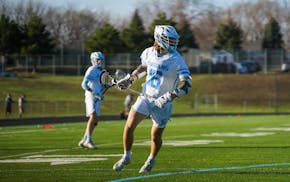Back when green space in St. Paul's North End consisted mainly of Oakland Cemetery, most residents didn't know that a stream ran through their neighborhood to the river.
That's because they couldn't see it.
But the old-timers knew that Trout Brook long had been buried in a pipe by the railroads, which laid tracks atop the streambed to ensure a smooth descent into the downtown yards.
Now a new and winding streambed for the brook, which runs through a stormwater tunnel near Interstate 35, has been carved down the middle of the 42-acre Trout Brook Nature Sanctuary and Regional Trail, which is slated for official opening next spring.
It's called "daylighting," the process of unearthing a stream typically filled in by urban development, and it's an increasingly popular strategy to improve water quality and aid neighborhoods in need of natural amenities.
"It's gorgeous. You're down there and it's like a whole different world, so different from what we all grew up with and what it's been up to now," said Tri Area Block Club Chair Linda Jungwirth, who oversaw a 20-year campaign to transform the brownfield site into park space.
The $10.2 million Trout Brook Sanctuary, owned and operated by the St. Paul Parks and Recreation Department, is one of at least three projects in recent years involving restoration of buried streams that flow into the Mississippi River.
A covered portion of Bassett Creek in north Minneapolis was opened at the Heritage Park housing project, and a developer spent up to $2 million to unearth part of Shingle Creek alongside a new shopping mall in Brooklyn Center.
Daylighting streams is occurring across the country and overseas, in places such as Hutchinson, Kan.; Yonkers, N.Y.; and Seoul, South Korea. National Geographic reported last year that more than 70 percent of streams are paved over in some cities.
"Water resources are hidden in so many cases," said Deborah Karasov, executive director of Great River Greening, a St. Paul-based nonprofit that promotes land and water restoration. "Once you put it on the surface, once it's visible and in front of you, it brings awareness to a whole new level."
'A stream to support life'
The Trout Brook sanctuary grew out of a neighborhood movement in the 1990s to turn the site into a greenway linking what would become the Bruce Vento Nature Sanctuary, on the east, with Lake McCarrons in Roseville.
The alternative, Jungwirth said, was "a school-bus yard … and other uses such as construction storage, and we didn't feel that was the highest and best use."
Finally persuaded by the neighbors, the city bought the so-called Trillium property in 2001 in part with state and local grants awarded to the block club.
The plan evolved into a preserve with trails and an exposed Trout Brook, which the Capitol Region Watershed District helped design and fund. It wasn't a simple project, said Bob Fossum, the district's water resource project manager.
In some places, the soil was so contaminated it had to be replaced with 4 feet of clean fill. And then there was the better-than-average length of the restored streambed, a little more than a half-mile.
"We don't have anything close to this in our watershed," Fossum said.
A new streambed was excavated to the west of where the actual brook ran, and a water system was built to treat stormwater runoff underground, divert it into three sand-filtration ponds — where pollutants are broken down by the sun and bacteria — and then discharge it into the brook.
From there the water flows into the Sims Agate stormwater pond, where it's held before being released underground into the river.
"We want a stream channel that can ultimately support life such as fish and waterfowl," Fossum said.
Right now, the only water in the brook comes from the sky. But when the diversion is opened next year, the brook will drain about 200 of 240 acres in the immediate area with the stormwater tunnel handling the balance.
Kathleen Anglo, the city's project manager who designed the preserve's trails and overlook, said it would be nice to someday open up the brook all the way to the Mississippi. But it will take time as parcels are redeveloped, she said.
"We're in a built environment and we don't have a lot of instances where we're getting these park spaces back," she said.
The final task at Trout Brook is planting white oak trees and shrubs, a job being led by Great River. About 2,500 have been planted, with more on the way, Karasov said.
Last weekend, in a ceremony attended by Minnesota Twins owner Jim Pohlad and former Twin Randy Bush, Great River received a $65,000 All-Star Legacy grant from the baseball team for plants at Trout Brook.
The next St. Paul stream to be daylighted? Perhaps Hidden Falls Creek, a channel that's open in the park but has been buried for years where it crosses the site of the former Ford plant. Redevelopment of that site could provide the opportunity.
In the meantime, Jungwirth is relishing the prospect of finishing Trout Brook.
"Twenty years of trying to make it happen — it's just hard to believe it's happened," she said.
Kevin Duchschere • 651-925-5035

University of Minnesota says it reaches deal to end pro-Palestinian encampment

Fact check: Controlled substances not part of senator's burglary case
2nd man charged in midnight shootout on Lake Street that left man dead and woman injured

A new team resides atop the boys lacrosse rankings

